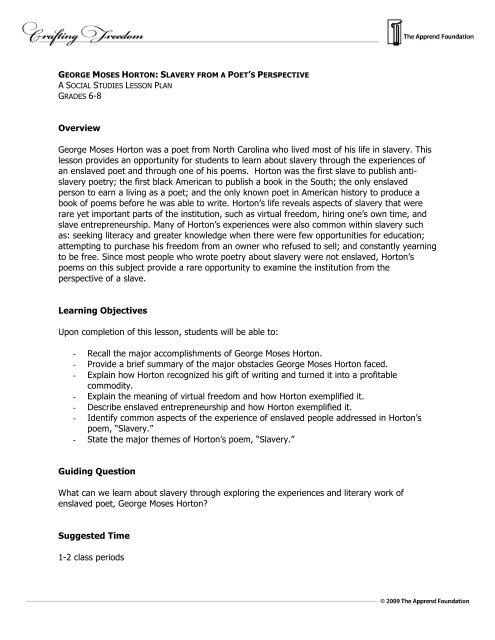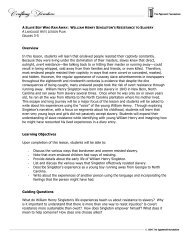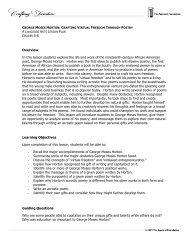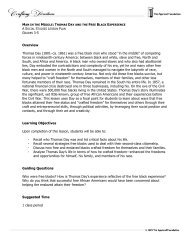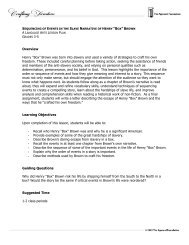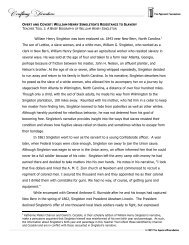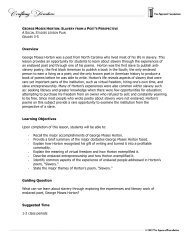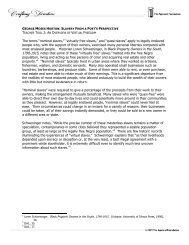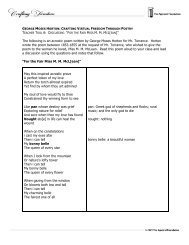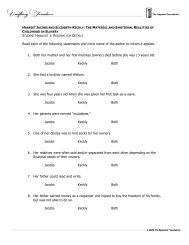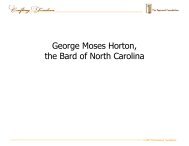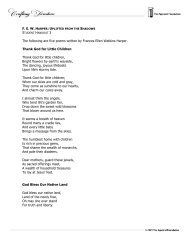George Moses Horton Lesson Plan - Crafting Freedom
George Moses Horton Lesson Plan - Crafting Freedom
George Moses Horton Lesson Plan - Crafting Freedom
Create successful ePaper yourself
Turn your PDF publications into a flip-book with our unique Google optimized e-Paper software.
GEORGE MOSES HORTON: SLAVERY FROM A POET’S PERSPECTIVE<br />
A SOCIAL STUDIES LESSON PLAN<br />
GRADES 6-8<br />
Overview<br />
<strong>George</strong> <strong>Moses</strong> <strong>Horton</strong> was a poet from North Carolina who lived most of his life in slavery. This<br />
lesson provides an opportunity for students to learn about slavery through the experiences of<br />
an enslaved poet and through one of his poems. <strong>Horton</strong> was the first slave to publish antislavery<br />
poetry; the first black American to publish a book in the South; the only enslaved<br />
person to earn a living as a poet; and the only known poet in American history to produce a<br />
book of poems before he was able to write. <strong>Horton</strong>’s life reveals aspects of slavery that were<br />
rare yet important parts of the institution, such as virtual freedom, hiring one’s own time, and<br />
slave entrepreneurship. Many of <strong>Horton</strong>’s experiences were also common within slavery such<br />
as: seeking literacy and greater knowledge when there were few opportunities for education;<br />
attempting to purchase his freedom from an owner who refused to sell; and constantly yearning<br />
to be free. Since most people who wrote poetry about slavery were not enslaved, <strong>Horton</strong>’s<br />
poems on this subject provide a rare opportunity to examine the institution from the<br />
perspective of a slave.<br />
Learning Objectives<br />
Upon completion of this lesson, students will be able to:<br />
- Recall the major accomplishments of <strong>George</strong> <strong>Moses</strong> <strong>Horton</strong>.<br />
- Provide a brief summary of the major obstacles <strong>George</strong> <strong>Moses</strong> <strong>Horton</strong> faced.<br />
- Explain how <strong>Horton</strong> recognized his gift of writing and turned it into a profitable<br />
commodity.<br />
- Explain the meaning of virtual freedom and how <strong>Horton</strong> exemplified it.<br />
- Describe enslaved entrepreneurship and how <strong>Horton</strong> exemplified it.<br />
- Identify common aspects of the experience of enslaved people addressed in <strong>Horton</strong>’s<br />
poem, “Slavery.”<br />
- State the major themes of <strong>Horton</strong>’s poem, “Slavery.”<br />
Guiding Question<br />
What can we learn about slavery through exploring the experiences and literary work of<br />
enslaved poet, <strong>George</strong> <strong>Moses</strong> <strong>Horton</strong>?<br />
Suggested Time<br />
1-2 class periods
Preparing to Teach the <strong>Lesson</strong><br />
1. If you are already familiar with <strong>George</strong> <strong>Moses</strong> <strong>Horton</strong>, skip to step 2. To learn about<br />
<strong>Horton</strong> you can read a brief biography in Teacher Tool 1. You can also read an<br />
overview of his life at http://docsouth.unc.edu/fpn/hortonlife/bio.html.<br />
2. For a greater understanding of <strong>Horton</strong>’s views of slavery, you may read some of his<br />
other works such as:<br />
- “The Slave’s Complaint” at http://docsouth.unc.edu/southlit/horton/horton.html<br />
- “On Slavery and Liberty” at<br />
http://www.theotherpages.org/poems/2001/horton0101.html<br />
- “Division of an Estate” at http://docsouth.unc.edu/fpn/hortonpoem/menu.html<br />
- “The Creditor and his Proud Debtor” at<br />
http://docsouth.unc.edu/fpn/hortonpoem/menu.html<br />
- “<strong>George</strong> <strong>Moses</strong> <strong>Horton</strong>, Myself” at<br />
http://www.theotherpages.org/poems/2001/horton0105.html<br />
3. Review Teacher Tool 2, which provides an overview of virtual freedom.<br />
4. Review Teacher Tool 3, which provides an overview of enslaved entrepreneurship.<br />
5. Review the PDF slide show that accompanies this lesson plan and Teacher Tool 4. The<br />
PDF slides are intended to introduce students to <strong>George</strong> <strong>Moses</strong> <strong>Horton</strong> and Teacher Tool<br />
4 contains lecture notes on the life of <strong>Horton</strong> to accompany each of the slides.<br />
6. Review Teacher Tool 5, which contains the poem, “Slavery” and notes based on the<br />
questions to help you lead a discussion on the poem.<br />
7. Review Student Handout 1, which contains question about <strong>George</strong> <strong>Moses</strong> <strong>Horton</strong>’s life<br />
based on each PDF slide.<br />
8. Review the short video “<strong>George</strong> <strong>Moses</strong> <strong>Horton</strong>, Poet Entrepreneur.” This video<br />
demonstrates how <strong>Horton</strong> turned his literary talent into a business writing love poems.<br />
This venture was a precursor to the greeting card business of today.<br />
9. Review Student Handout 2, which contains the poem “Slavery” and questions for<br />
students to answer. Notes to help you discuss the poem are provided in Teacher Tool 5.<br />
Teaching the <strong>Lesson</strong> (Suggested Steps)<br />
1. Explain to students that the topic of the lesson is a man named <strong>George</strong> <strong>Moses</strong> <strong>Horton</strong>,<br />
an American poet who lived in the South before the Civil War. To engage student<br />
interest, open the lesson plan by showing the short video titled “<strong>George</strong> <strong>Moses</strong> <strong>Horton</strong>,<br />
Poet Entrepreneur.” Withhold that <strong>Horton</strong> was enslaved until after students see the<br />
video as this should come as a surprise and spark further interest in <strong>Horton</strong>.<br />
2. Using Teacher Tool 4 as a lecture reference, present the PDF slide show to introduce<br />
<strong>George</strong> <strong>Moses</strong> <strong>Horton</strong>. Stop the slide show at slide 9. Slides 10 and 11 will be used<br />
later.<br />
3. Distribute Student Handout 1 and show each slide again, allowing students time to write<br />
a brief response to each question.<br />
4. Using the information in Teacher Tools 2 and 3, provide students with an overview of<br />
the concepts of virtual freedom and enslaved entrepreneurship, noting that <strong>Horton</strong><br />
turned his poetry into a successful business, which allowed him to live in virtual freedom<br />
while paying his owner a portion of his profits. Be sure to note that not all of <strong>Horton</strong>’s<br />
experiences as a slave were unusual, highlighting the many limitations that he shared<br />
with the majority of those enslaved such as seeking literacy and greater knowledge<br />
when there were few opportunities for education; attempting to purchase his freedom
from an owner who refused to sell; and constantly yearning to be free.<br />
5. Show PDF slides 10 and 11, which present <strong>Horton</strong>’s poem, “Slavery.” Read the poem<br />
aloud to your class.<br />
6. Distribute Student Handout 2 and ask students to read <strong>Horton</strong>’s poem to themselves<br />
and answer the questions about the poem that follow.<br />
7. Using the information provided in Teacher Tool 5, lead a discussion about <strong>Horton</strong>’s<br />
poem.<br />
Extending the <strong>Lesson</strong><br />
- Ask students to compare <strong>George</strong> <strong>Moses</strong> <strong>Horton</strong>’s “Slavery” with his earlier poem on this<br />
subject titled “On Slavery and Liberty.” You may also want students to compare and<br />
contrast the poems “The Slave” and “A Slave’s Reflections on the Eve Before His Sale”.<br />
Ask students the same questions presented in Student Handout 2. You may also have<br />
students compare and contrast themes, images, and views of the institution of slavery<br />
conveyed in the poems.<br />
- Ask students to compare two works written about the institution of slavery in the year<br />
1829: <strong>George</strong> <strong>Moses</strong> <strong>Horton</strong>’s “On Liberty and Slavery” and David Walker’s Appeal to the<br />
Colored Citizens of the World. David Walker was a free black who left North Carolina<br />
and moved to Boston. His Appeal called for immediate emancipation and for slaves to<br />
rise up. Walker’s work was banned in North Carolina and other southern states. In<br />
addition to the lesson, video, and other material on Walker on this website, you can<br />
read a biography on David Walker at http://docsouth.unc.edu/nc/walker/bio.html, a<br />
summary of the Appeal at http://docsouth.unc.edu/nc/walker/summary.html, and the<br />
full text of the Appeal at http://docsouth.unc.edu/nc/walker/menu.html.<br />
- <strong>George</strong> <strong>Moses</strong> <strong>Horton</strong> catered to specific audiences in order to earn a living. For<br />
example, he wrote love poems for students at a university primarily to earn enough<br />
money to live in virtual freedom, away from the constant supervision of his owner.<br />
When an artist caters to the interests or needs of a particular group purely to make<br />
money do you think he or she is compromising their talent and “selling out” or simply<br />
trying to survive? Explain your feelings about this topic.<br />
Teachers may use and reproduce the material on the <strong>Crafting</strong> <strong>Freedom</strong> website for instructional purposes.


